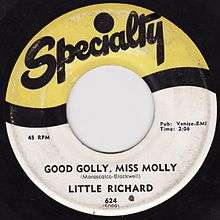Good Golly, Miss Molly
"Good Golly, Miss Molly" is a hit rock 'n' roll song first recorded in 1956 by the American musician Little Richard and released in January 1958 as Specialty single 624 and next in July 1958 on Little Richard.[1] The song, a jump blues, was written by John Marascalco and producer Robert "Bumps" Blackwell. Although it was first recorded by Little Richard, Blackwell produced another version by the Valiants, who imitated the fast first version recorded by Little Richard, not released at that time. Although the Valiants' version was released first (in 1957), Little Richard had the hit, reaching #4.[2] Like all his early hits, it quickly became a rock 'n' roll standard and has subsequently been recorded by hundreds of artists. The song is ranked #94 on the Rolling Stone magazine's list of the 500 Greatest Songs of All Time.[3]
| "Good Golly, Miss Molly" | ||||
|---|---|---|---|---|
 | ||||
| Single by Little Richard | ||||
| from the album Little Richard | ||||
| B-side | "Hey-Hey-Hey-Hey" | |||
| Released | January 1958 | |||
| Format | 7", 45rpm | |||
| Recorded | October 15, 1956 J&M Studio, New Orleans, Louisiana | |||
| Genre | Rock and roll | |||
| Length | 2:04 | |||
| Label | Specialty (Cat. no. 624) | |||
| Songwriter(s) | John Marascalco, Robert "Bumps" Blackwell | |||
| Producer(s) | Robert "Bumps" Blackwell | |||
| Little Richard singles chronology | ||||
| ||||
Song origin
Little Richard first heard the phrase "Good golly, Miss Molly" from a Southern DJ named Jimmy Pennick.[4] He modified the lyrics into the more suggestive "Good golly, Miss Molly/You sure like to ball." Little Richard himself later claimed that he took Ike Turner's piano intro from his influential 1951 rock and roll song "Rocket 88," and used it for "Good Golly, Miss Molly." "I always liked that record," Richard recalled, "and I used to use the riff in my act, so when we were looking for a lead-in to 'Good Golly, Miss Molly', I did that and it fit."
Little Richard Specialty recording sessions
July 30, 1956: J&M Studio, New Orleans
Supervised by Bumps Blackwell. Personnel:
- Little Richard - vocal, piano with:
- Lee Allen - tenor saxophone
- Alvin "Red" Tyler - baritone saxophone
- Roy Eustis Montrell - guitar
- Frank Fields - leader, bass
- Earl Palmer - drums
One take and one false start from this session were released in 1989 on Little Richard Specialty Sessions (Ace Records sets) as fast versions.
October 15, 1956: J&M Studio, New Orleans
Supervised by Art Rupe. Personnel:
- Little Richard - vocal, piano with:
- Lee Allen - tenor saxophone
- Alvin Tyler - baritone saxophone
- Roy Eustis Montrell - guitar
- Frank Fields - bass
- Earl Palmer - leader, drums
At least ten takes were recorded. Take 9 was selected as master for single and album of 1958. Three other takes were released in 1989 on Little Richard Specialty Sessions (Ace Records sets).[5]
Little Richard later studio recording sessions
After leaving Specialty Records Little Richard returned to "Good Golly, Miss Molly" many times. In particularly, he recorded this song:
- Circa December 1964 for Vee-Jay Records, released on Little Richard's Greatest Hits
- In December 1965 for Modern Records, released on The Wild and Frantic Little Richard
- On January 25, 1967 for Okeh Records, released on Little Richard's Greatest Hits: Recorded Live!
- In May 1970, private recording made at the Boston Tea Party, was officially released by Shout! Records, in the 2000s.
- Circa late 1972 for the film Let the Good Times Roll, released by Bell Records circa May 1973 as single Bell-1780 without flip and on double LP Let the Good Times Roll (Original Soundtrack)
- In August 1976 for K-tel International, released on Little Richard Live
These are studio recordings.[6]
Other versions
In November 1962 Jerry Lee Lewis released the single "Good Golly Miss Molly" (Sun 382), reissued on compilation album Breathless (1967) and on Rockin' Rhythm & Blues (1969).
In 1964 The Swinging Blue Jeans covered the song. It was a hit as part of the British Invasion and one of the band’s best known songs.
In 1966, Mitch Ryder and the Detroit Wheels incorporated Good Golly Miss Molly into their version of Devil With the Blue Dress On. Their version scored a major hit, not only in Ryder's native Detroit, but nationwide, placing at #4 on the Billboard Top 100.
Creedence Clearwater Revival recorded the song in 1969 on their Bayou Country album with slightly changed lyrics.[7]
References
- White, Charles (1994). The Life and Times of Little Richard: The Quasar of Rock. Da Capo Press. p. 259. ISBN 0-306-80552-9.
- "Good Golly, Miss Molly (song by Little Richard) ••• Music VF, US & UK hits charts". Musicvf.com. Retrieved 2015-11-09.
- "Rolling Stone's 500 Greatest Songs of All Time". Rolling Stone. April 2010. Retrieved September 28, 2015.
- Charles White (2013-03-15). "The Life And Times Of Little Richard: The Authorised Biography". Books.google.com. Retrieved 2015-11-09.
- Little Richard – The Specialty Sessions – 8 Album Set (booklet). London: Ace Records Ltd. 1989. p. 29. ABOXLP 1 (set), ABOXBK1 (booklet).
- White, Charles (1994). The Life and Times of Little Richard: The Quasar of Rock. Da Capo Press. ISBN 0-306-80552-9.
- Gilliland, John (1969). "Show 54 - Hail, Hail, Rock 'n' Roll: Getting back to rock's funky, essential essence. [Part 3]" (audio). Pop Chronicles. University of North Texas Libraries.